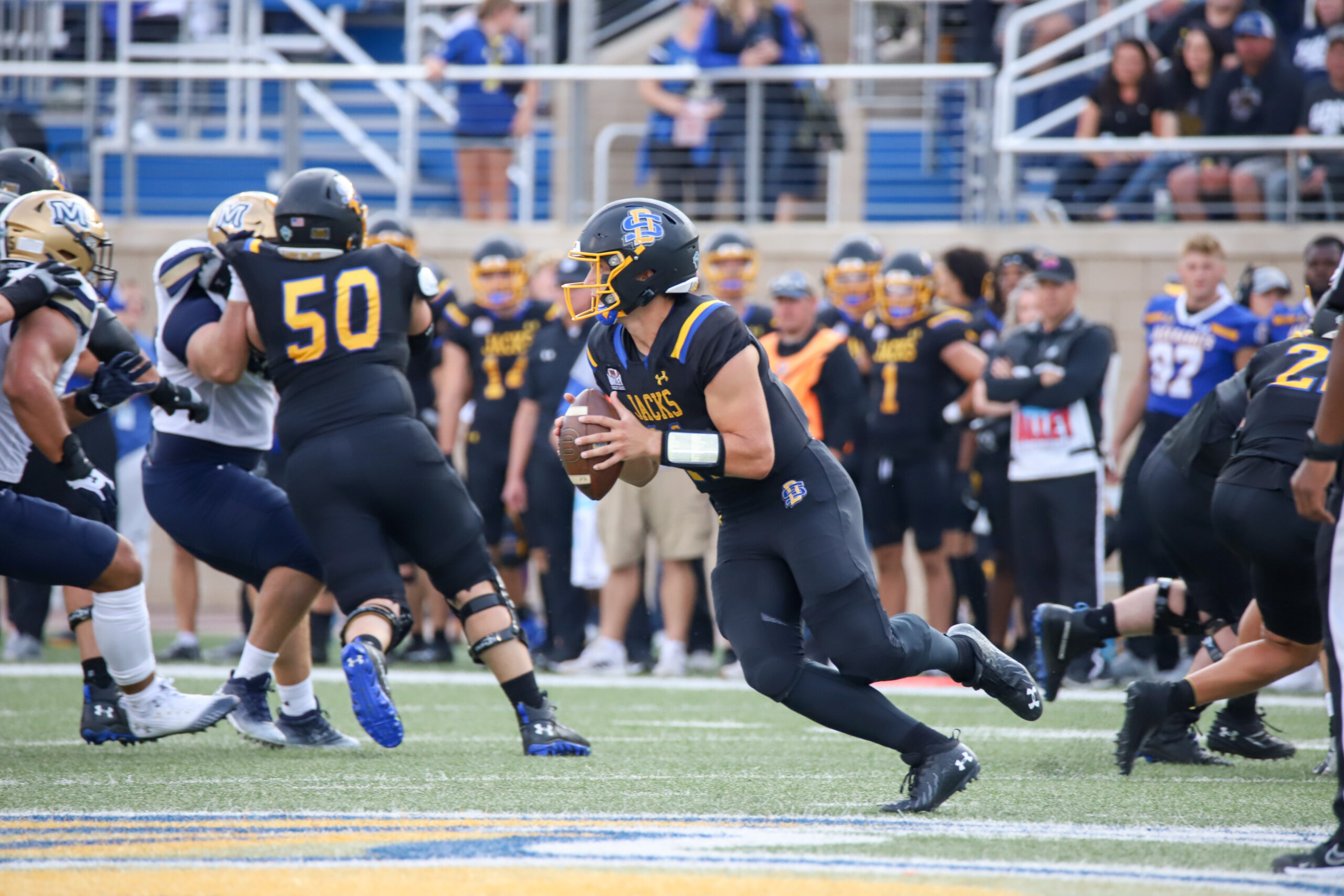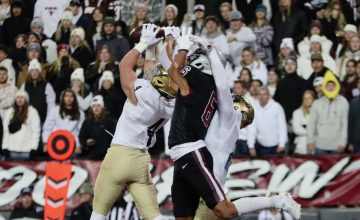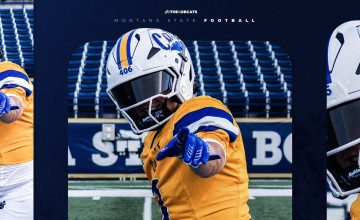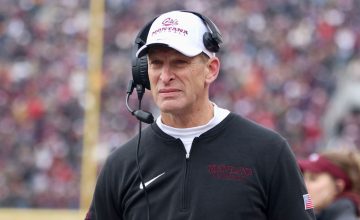Despite playing in different conferences, Montana and South Dakota State have had plenty of common opponents over the past few years between non-conference schedules and playoff meetings. To get the inside scoop on what we’ll see on the field on Sunday, Skyline Sports reached out to multiple coaches and coordinators who have played against both Montana and South Dakota State in the past few years for an anonymous scouting report. This, from the coaches who have played them, is the definitive scouting report on the Grizzlies’ and Jackrabbits’ offense.
For the companion report on Montana and SDSU’s defenses, click here.
Just like their defense, South Dakota State’s offense is elite, ranking third in the country in scoring and sixth in total offense.
“South Dakota State is very physical, really good running backs,” said one defensive coach. “A veteran quarterback. So they don’t take very negative plays at all. They’re just machine-like, and their tight end play is really, really good. So that’s what makes them go, is that they have really big tight ends that can catch passes and create a lot of issues in the run game. They block so well compared to other teams that usually don’t have tight ends that are big and physical that can run.”
With quarterback Mark Gronowski, running back Isaiah Davis, receivers Jaxon and Jadon Janke and tight end Zach Heins, the Jackrabbits have All-American candidates at every skill position. But it’s their offensive line, nicknamed the “605 Hogs,” that drives SDSU’s offense.
“The SDSU offensive line is big, athletic, and plays very well together,” said a different defensive coordinator. “They have a lot of run game out of multiple personnel groupings with creative ways of shifting and motioning, so limiting the run game will help get them behind the sticks. We decided to commit to stopping the run by creating plus-one and plus-two boxes. In clear passing situations we applied pressure.”
“They’re as good as advertised if they get ahead,” said the first coach. “I think Montana will give them some issues because so many people don’t blitz them. The teams that have been aggressive against them have slowed them down. But if they get ahead against you, and they can just take three or four yards and be patient, they’re really difficult to come back on.”
– Jimmy Rogers, "one of the best defensive minds in FCS"
— Andrew Houghton (@AndrewH202) January 6, 2024
– The legendary NFL defense that Montana's new scheme resembles
– How to attack two of the best defenses in the country
The definitive scouting report on the Montana and SDSU defenses⬇️https://t.co/KB4ff6oG0h
The Jackrabbits also feature Davis, a legitimate NFL prospect who will be following in the footsteps of his former teammate Pierre Strong if he makes it to the league.
“They are very different, but I think what Davis does translates to the NFL better,” said the second anonymous coach. “Strong was more of a home-run hitter, where Davis will get you the tough yards after contact.”
SDSU quarterback Mark Gronowski led the Jackrabbits to the national title game in the spring 2021 season as a true freshman before missing the fall season with an injury. He’s started ever since.
“He’s super efficient, and he’s sneaky athletic,” said a third anonymous coach, an offensive coordinator who evaluated both quarterbacks for this article. “He’s a better thrower than (Montana QB) Clifton (McDowell) if you were a scout watching him. And I think SDSU has done such a good job of using enough quarterback run game to showcase his size and his athleticism. They’ve always been strong on the perimeter, particularly with play-action. They scheme guys open, or he just does a good job of giving guys opportunities. I don’t think he’s in the top five premier passers in the FCS, but if you talk about a quarterback playing within his system and playing really well, he’s got to be at the top of the list.”
“He’s just really steady and you know, he’s another guy that can run the ball so you have to account for him in the run game,” said the first defensive coordinator. “Anytime you know he can do that, it’s really hard to play a lot of zone coverage. Third-and-5, they’ll run pick routes against man coverage, but if you’re trying to zone him you know he’ll run for the first down. Montana will be trying to get those guys into third and long like against any good offense, but if you can do it, then that’s not really what they do. They’re not really a vertical passing team, so if Montana can get some negative plays, that’s really helpful.”
That coach also compared the Jackrabbits to a familiar opponent for Montana.
“They’re very similar to Idaho,” he said, which would make sense considering Idaho head coach Jason Eck was South Dakota State’s offensive coordinator from 2016 until 2021.
“They’re almost identical to what Idaho does, kind of a mid zone but they’ll have a trick play here and there. And then those two twin receivers (the Jankes) have been there forever, it seems like, and they always end up making contested catches. They don’t look as fast as some of the people you might play, but they seem to come down and catch everything. They do a good job changing their splits. That’s the hardest thing about them. Their receivers will be tight and then they’ll be wide. Then they’ll be on the other side. They motion about almost every other play. So they do a good job of disguising their looks.”

Montana, meanwhile, has flipped the switch on offense after going to Clifton McDowell as the full-time starter at quarterback four games into the season.

“I think he’s an average thrower who surprises you, because he looks ugly throwing it but he completes enough balls,” said our quarterback evaluator. “Kind of like Vince Young when he was playing for the Titans. And he’s so dang big. He’s played so smart for them. I think he does a great job. He throws some ugly balls, but he throws them in the right spot, and he does a good job throwing the ball away when it’s not there. He’s dang near impossible to sack, so you can’t create negative plays because the Griz do a good enough job in the run game. And that’s what I think was Bobby (Hauck’s) thought process of, hey, let’s go to Clifton, because they should have been NAU by 40. Not only is he probably going to throw it away sooner than the previous guys were, if you get there he’s hard to bring down, so he mitigates negative plays. He takes care of the football and he’s a threat in the run game which makes him a problem.”
“I think he’s really hard to get on the ground,” said the first defensive coordinator. “So if you pressure him and you miss him, there’s big plays down the field because you have to cover for so long. And then you don’t really know, based on their personnel, what formations they’re going to be. They might be two tight ends, but they’ll run empty and they’ll run the quarterback. So if you’re trying to attack a protection with a blitz, they can end up running one of those quarterback runs and he could be out for a big gain. So the combination of him being able to run and then him not turning the ball over, along with him making timely throws, that really helps them. Then once they’re ahead, they’re able to run the ball multiple ways instead of just one way. They can run it outside or inside, run it with a running back and run the quarterback. They can run it with fly sweeps. They have a lot of different ways to run the football once they get a lead on people.”
Montana replaced offensive coordinator Timm Rosenbach with Brent Pease before the season. The change has paid dividends, particularly later in the season, which this coach also noted.
“Their receivers were so much more explosive this year,” he said. “They’ve created so many more explosive plays. I would say that’s the number one thing they have to do against South Dakota State. They have to create explosive plays with the wide receivers, because South Dakota State plays really tight quarters. You have to win at the slot position against their safeties, because outside the corners do a pretty good job and they have a lot of underneath help, so you really have to win at the slot position. Montana has done that all year with (Junior) Bergen. They’ve hit in-breaking routes across the middle, and they’ll have to be explosive in the passing game.”
“No. 14 (Aaron Fontes), he’s a deep threat. Even though sometimes he might not get the ball, he’ll clear out the zone so that one of those other guys can come up from across the field underneath and create big plays. (Fontes) is pretty fast, and he does a good job of putting stress on the middle of the field. He’s kind of the guy that takes the defense and stretches it vertically with his speed so that they can create some of those other easy throws that they do. Or, those guys are so far down the field and then the quarterback gets out and scrambles. That happened a couple times in the semifinal game, where those guys are so far down the field the defense had to turn and get depth to try to stop those over routes, and then it creates explosive plays with the quarterback running.”

One other tweak that unlocked Montana’s offense in the second half of the season was playing with wide splits, or more space between players on the offensive line. This coach explained why that’s been so effective.
“It creates more space for the quarterback when they run the ball with the quarterback up inside,” he said. “With those big splits, they kind of want to invite you to blitz in the middle of the defense. And then they’re able to block everybody down and pull a guard around and either have the quarterback run or get the ball on the perimeter with their tailback. Like the toss play (Eli) Gillman hit against Idaho. They got the corner, he made one person miss and it was, you know, an 80-yard play. The splits dare you to go inside, because if you don’t put guys inside then there’s some big running lanes inside.”
















